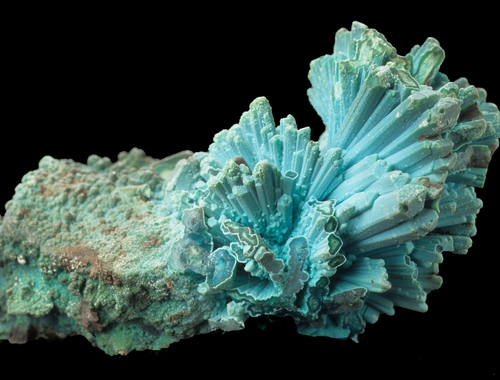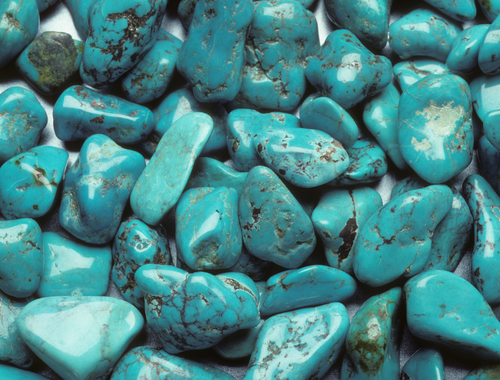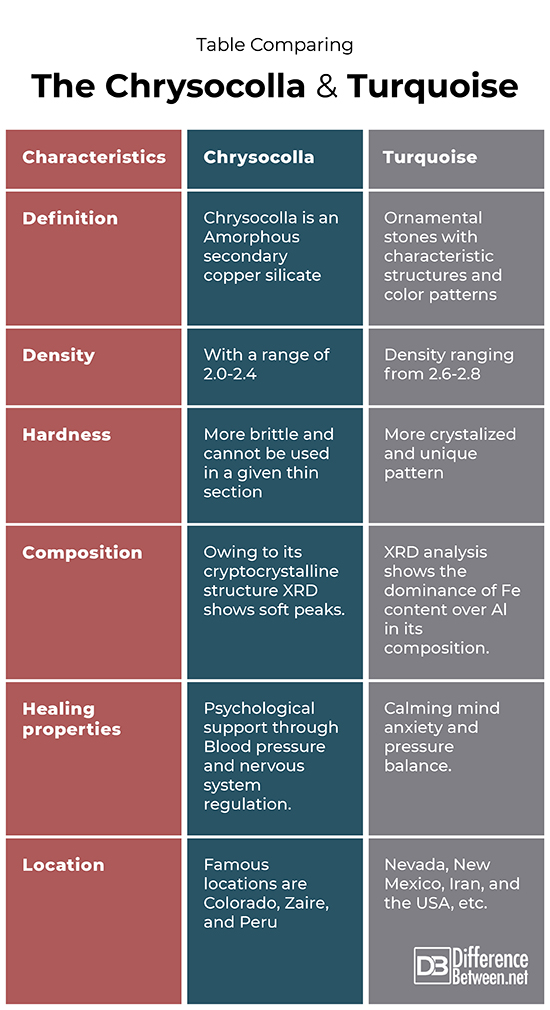Difference Between Chrysocolla and Turquoise
Minerals that cannot be distinguished commonly but are remarkably different in chemical composition, properties, and uses; chrysocolla and turquoise are one of them.

Chrysocolla:
Definition:
It is a secondary copper silicate with a habitual amorphous structure. Studies have shown the plentiful occurrence of chrysocolla in oxidized copper mineral forms (Roberts et al.).
Structural study:
General composition:
A fibrous microcrystal chain was proposed for chrysocolla ranging from 0.5 to 3 microns (Van Oosterwyck-Gastuche and Grégoire). The crystalline form of chrysocolla in upper levels of B Tangye Lode (Great Australia) is only comparable with that of Trafalgar’s deposits (south of Cloncurry).
Chrysocolla has the general formula Cu2H2 (Si2O5). (OH)4. Chrysocolla was also recognized as a hydrogel precipitate despite its mineral form by Foote and Bradley. Silica, water, and cupric oxide are essential components in their chemistry. Chrysocolla composition is conditions dependent.
Measuring Techniques
- XRD analysis;
The XRD analysis shows the pattern of natural chrysocolla as an amorphous structure. XRD study shows broad diffuse bands of diffraction maxima, measuring which is a challenging task (Sun). In light of XRD patterns, there is a variation in chrysocolla order stages. They are also cryptocrystalline and placed in copper-stained amorphous form from section to section.
- Electron microscopic analysis;
With magnification power higher than 70,000 times, an electron microscopic study could analyze selected Chile specimens. Electronic beam diffraction uncovers three-dimensional order to a minimum level
Color and spectrum composition:
Studying chrysocolla samples from Chile, banded, ranging in color from white-milky to greenish blue under the absorption spectra. Cracking and inelasticity in haphazard directions were observed to a great deal in the handy specimen (Newberg)

Turquoise:
Definition:
Turquoise is an Ornamental stone with striking assembly in the copper silicate minerals. The general formula of natural turquoise CuAl6(PO4)4(OH)8.4(H2O) has concentrations of 10 percent CuO and 38 percent Al2O3, respectively (Foord and Taggart).
Structural study:
General composition:
Turquoise-faustite series is one of the series to which all the turquoises fit. Chemical analysis of the various samples shows Cu percentage up to 4.90 and Fe ranging from 0.39 to 6.38 portions were also recognized in a few pieces (Clark et al.). With less than a 1 percent ratio, Zn is also present in the composition of turquoise CuAl6(PO4)4(OH)8.4(H2O). Iron Fe occurs in the form of Fe+3 ions in the crystalline structure of turquoise. The lowering of Al content was observed with the increase of Fe in the samples.
Measuring techniques:
- XRD Analysis
The peculiar difference in color spectra is closely concerned with the iron (Fe) content which substitutes the Aluminum (Al) concentration as shown by XRD analysis. In the same way, the regular shift of the absorption band also plays its role in color changes from blue to yellow and then to yellow. From the exact concentration of Copper and iron ions in a sample taken from turquoise magnetic susceptibility can be measured.
- High-temperature absorption spectroscopy;
Discussing move next to high-temperature absorption spectroscopy for checking the water influence on turquoise color, and the results show less impact of water content on turquoise color present in it. Color changes took place from blue to greyish-green or green with the increase in temperature.
Color and spectrum composition:
The color tones of turquoise, having different wavelengths in the blue and green spectrum, also differ from the naturally occurring turquoise in copper silicate minerals (Qiu et al.). Natural turquoise has unique colors which vary according to its composition.
With increasing Fe content in the turquoise, a color change took place from blue to green and next to yellow. Such a study shows considerable concern about Fe content with the turquoise color. Turquoise shows the Absorption bands of 422nm and 435nm in the absorption spectra due to the haunting effect of Fe+3 over the Al+3 ions. Long wavelengths were observed with the widening of bands and increasing bands shifts. (Zhang et al.)
Difference between chrysocolla and turquoise
Definition:
Chrysocolla is a secondary copper silicate with typical amorphous composition. The definition of turquoise has two parts cultural and chemical. The cultural description covers not only the chemical composition but also various types of other blue-green stones, including chrysocolla
Density:
The chrysocolla has a low density of 2.0 to 2.4 compared to turquoise, with 2.6 or more (Lamberg et al.).
Hardness:
Chrysocolla easily breaks down while used in thin sections due to its brittleness. The turquoise has a more definite crystalline structure than the chrysocolla.
Composition:
Silica, water, and cupric oxide are essential components in their chemistry. Chrysocolla composition depends upon the conditions that vary from sample to sample. Its primary constituents are Water, silica, and cupric oxide. In the turquoise case, Copper, iron, zinc, etc., with respective concentrations are present.
Locations:
Chrysocolla can be found in different locations around the world; it can be found in Colorado, Zaire, and Peru, etc. sky-blue turquoise is the most expensive type of turquoise and is located in Iran, similarly also branched in Nevada and Mexico.
Healing properties:
The chrysocolla and turquoise can be helpful as psychological and stress relieving agents and many others. Wearing Chrysocolla stones according to personality match regulates blood pressure and nerve-related problems. The turquoise stone helps calm the mind’s chaotic conditions and ant-inflammatory characteristics (Chocron).
Table comparing the chrysocolla and turquoise:

Summary:
Many of the minerals are mistaken as the same due to their color and texture resemblance, but there are considerable differences can be measured. Like in chrysocolla and turquoise, significant differences based on their composition, color and structure pattern, physical and healing properties, etc., were considered in the current study.
FAQ
Is chrysocolla the same as turquoise?
Although both have some similarities, they are minerals found in arid regions and are often considered the same due to their identical appearance. Yet they are not the same in several manners.
How do you identify chrysocolla?
The easiest way is to lick. Chrysocolla has a unique blue color and amorphous structure, and its density ranges between 2.4 and 2.6.
Is chrysocolla expensive?
The expense of chrysocolla varies in different regions. As usual, pure chrysocolla is an expensive mineral. The most costly chrysocolla type is a deep mix of turquoise with chrysocolla.
How do you tell chrysocolla from turquoise?
As shown by XRD analysis, turquoise has a blue-green color with a unique crystalline pattern. Hence, chrysocolla can be distinguished from turquoise considering its density, composition, physical and chemical properties, etc.
Is chrysocolla rare?
There is a deviation in the rarity order of chrysocolla. Its bluish-green band, with a hardness of more than 6 and 7, is considered the rarest material in exceptional jewelry design
- Difference Between Vascular Cambium and Cork Cambium - November 1, 2023
- Difference Between DevOps and Developer - September 10, 2023
- Difference Between Acute Gastritis and Chronic Gastritis - April 3, 2023
Search DifferenceBetween.net :
Leave a Response
References :
[0]Chocron, Daya Sarai. Healing with Gems and Crystals. Orient Paperbacks, 2005.
[1]Clark, C. O., et al. "Variable-Temperature Electron Spin Resonance of Turquoise." American Mineralogist, vol. 64, no. 3–4, 1979, pp. 449–51.
[2]Foord, Eugene E., and Joseph E. Taggart. “A Reexamination of the Turquoise Group: The Mineral Aheylite, Planerite (Redefined), Turquoise and Coeruleolactite.” Mineralogical Magazine, vol. 62, no. 1, 1998, pp. 93–111.
[3]Lamberg, Pertti, et al. "Mineralogical Balances by Dissolution Methodology." IMA Commission on Ore Mineralogy Short Course: 08/09/1997-10/09/1997, 1997.
[4]Newberg, Donald William. Geology and Mineralogy of Chrysocolla-Bearing Gravels. Harvard University, 1965.
[5]Qiu, Jun-Ting, et al. "Reflectance Spectroscopy Characteristics of Turquoise." Minerals, vol. 7, no. 1, 2016, p. 3.
[6]Roberts, Willard Lincoln, et al. Encyclopedia of Minerals. Van Nostrand Reinhold, 1990.
[7]Sun, Ming-Shan. "The Nature of Chrysocolla from Inspiration Mine, Arizona." American Mineralogist: Journal of Earth and Planetary Materials, vol. 48, no. 5–6, 1963, pp. 649–58.
[8]Van Oosterwyck-Gastuche, M. C., and Ch Grégoire. "Electron Microscopy and Diffraction Identification of Some Copper Silicates." Mineralogical Society of Japan Special Paper, vol. 1, 1971, pp. 196–205.
[9]Zhang, Huifen, et al. "Magnetic Properties, Characteristic Spectra and Colors of Turquoise." Geochemistry, vol. 3, no. 4, 1984, pp. 322–32.
